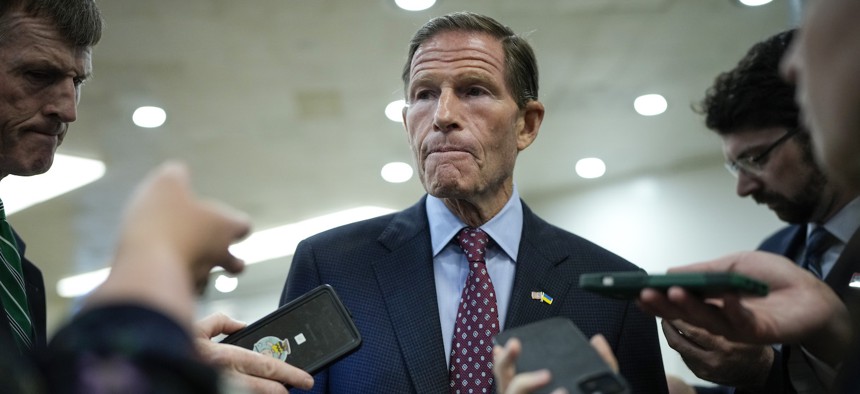US tech is still powering Russian weapons, experts warn

Sen. Richard Blumenthal, shown here taking questions from reporters in September 2023, is looking to ensure U.S. technology isn't used by Russian forces against Ukraine. Drew Angerer/Getty Images
American components that have been found in the sanctioned country’s weaponry are “fueling and supporting the growing and gargantuan Russian war machine,” said Sen. Richard Blumenthal, D-Conn.
As Russia and its allies continue to use U.S. companies’ components in their weapons despite sanctions and export controls limiting Moscow’s access to advanced technologies, the private sector must do more to ensure that its products are not being used to power Russia’s war against Ukraine, lawmakers and experts said during a Senate hearing on Tuesday.
U.S. officials rolled out a series of restrictive sanctions and export controls following Russia’s full-scale invasion of Ukraine in February 2022, with many of those initial measures — which have been subsequently expanded — designed to restrict Russia’s and Belarus’ access to semiconductors and other high-tech components needed to power advanced weaponry. But analyses of recovered Russian weapons and systems have shown that critical U.S. components are still being deployed on the battlefield.
Sen. Richard Blumenthal, D-Conn., who chairs the Senate Homeland Security and Governmental Affairs Permanent Subcommittee on Investigations, noted at the start of his panel’s hearing that he visited Ukraine last week as part of a congressional delegation and had the opportunity to meet with Ukrainian President Volodymyr Zelenskyy.
During the visit, Blumenthal said Zelenskyy provided him with documentation of at least 211 separate U.S.-made components that were recovered from Russian weapons and systems used in Ukraine, including “semiconductors and other American technology in numerous missiles and other high technology products used to kill Ukrainians.”
Blumenthal said that 87 of the identified separate components were made by just four companies: Advanced Micro Devices, Analog Devices, Intel and Texas Instruments. The panel previously disclosed that it has sought information from the four chip manufacturers, which have all said they are abiding by the U.S.’s export controls and sanctions.
Blumenthal said companies whose components were found in Russian weapons “know or should know whether they violated the law,” although he was quick to note that “we are not concluding” that they have intentionally evaded restrictions. But he highlighted the key role their components are nonetheless playing in Russia’s ongoing military offensive.
“American manufacturers are fueling and supporting the growing and gargantuan Russian war machine,” Blumenthal said, adding that “our sanctions system is a sieve, our export control regime is lethally ineffective and something has to be done.”
Experts at the hearing who have analyzed recovered Russian weaponry from the battlefields of Ukraine or studied Moscow’s efforts to circumvent existing U.S. export controls said that U.S. firms need to partner more closely with federal officials and work to strengthen oversight of their supply chains to reduce the flow of critical components to the Russian military. They also agreed with Zelenskyy’s findings regarding the continued flow of U.S. components to Russia.
Elina Ribakova — director of the international affairs program and vice president for foreign policy at the Kyiv School of Economics — said Ukraine’s National Agency for Corruption Prevention has identified roughly 2,800 non-Russian components in recovered weapons and that over 70% of them are from the U.S. She noted that export controls had an initial impact but that Russia has increasingly managed to sidestep these restrictions over the past two years.
“In the first month after the beginning of the full scale invasion in 2022, these imports had halved, so there was an impact,” she said. “But by 2023, we had only a 10% reduction in imports of these battlefield goods.”
Ribakova said reports she’s conducted found that Russia has changed up its approach to continue acquiring these components, relying more on partner nations and taking advantage of lax supply chain management to continue obtaining advanced technologies.
She noted that “components that are going to Russia tend to be produced outside the United States,” with U.S. firms manufacturing them in other countries that include China, Malaysia and the Philippines. These products are then increasingly shipped to distributors either bordering Russia or that have close ties to Moscow.
James Byrne, director of the open source intelligence and analysis department at the Royal United Services Institute think tank in London, said he and his team have examined recovered Russian weaponry and found that “they rely on our technology to build systems that are designed to threaten us and our allies.”
While Byrne acknowledged that “sanctions are difficult to enforce [and] export controls are difficult to enforce,” he said that companies “now know that many, many of their components” have ended up in Russian weapons.
“If I were them, obviously, I would be looking at my internal compliance departments and I would be thinking, ‘how far can I trace them?’” he added. “‘What can we do to improve our visibility in our supply chain?’”
The witnesses also said that private companies should engage more with outside organizations to better understand and prevent their products from being used in adversaries’ weapons.
Despite reaching out to and sharing their findings with semiconductor firms, both Byrne and Ribakova said they received limited responses from companies.
To strengthen the effectiveness of existing export controls, Ribakova said officials and organizations need more buy-in from private sector companies to stem the flow of critical technologies to Moscow.
“We need to tip that scale towards the companies themselves, investing in compliance departments that will catch the shipments before they reach the malign actors,” she said.






